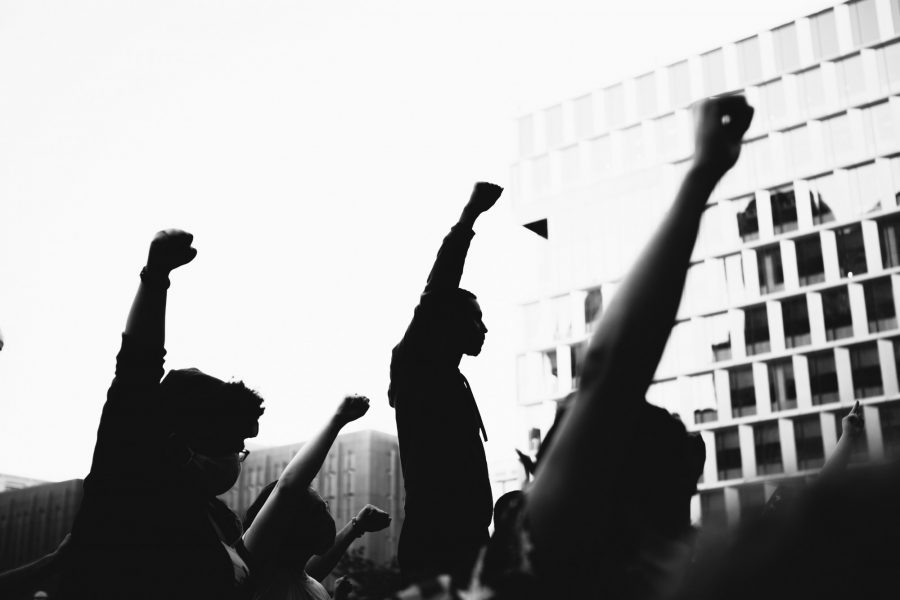The George Floyd protests not only brought Minneapolis together, but sparked a larger movement — the fight against systemic injustice — which soon took off across America. Some local photographers set out to capture the movement as it spread.
Isaiah Rustad is a photographer who first moved to the Twin Cities for college in 2013.
Rustad focuses his photography around capturing moments that evoke emotion and draw people to take action. “I want to make people feel something with my photos then hopefully they’ll act upon those feelings,” he said. “I can’t think of anything much stronger than protests happening around the killing of George Floyd.”
Rustad attended the very first George Floyd protest and has continued to document them since. “I want to showcase why they’re fighting and the passion these people have — whether it’s out of sadness or outrage,” Rustad said.
His favorite photo he’s shot of the protests is a close-up of people beginning to write on pavement in chalk near the Cup Foods in South Minneapolis, where Floyd was murdered. A list of the names of Black people who, like Floyd, were also killed by the police can now be found written in chalk on Chicago Avenue.
“Everyone has a lane and just keep your foot on the gas, whatever lane it is, to help fight injustice,” Rustad said.

Tina Nguyen is a 20-year-old photographer who attended University of Minnesota-Duluth her first year but now lives in the Twin Cities.
She took photos at protests in both Minneapolis and Duluth over the last two weeks.
Although Nguyen is actively taking photos, she said that many times after getting the shots she wants, her camera goes down so she can be in the moment.
Her main aim while taking photos of the protests is to share images of peaceful protesting. Many of the photos she’s taken are of protesters standing on a street corner, kneeling in front of police and participating in marches.
“I feel like I captured what needed to be captured…The peaceful protesting that we did,” Nguyen said.
She found it important to represent all kinds of people who showed up to the protests through her photography, such as kids holding up signs about Floyd. “Kids are the next generation,” Nguyen said. “They’ll grow up and see that they held the sign for the right reasons.”

Mariah Brink has been a wedding photographer for the last four years.
When Brink first found out about George Floyd and the protests, she wanted to take action.
Brink’s Instagram photos regularly get around 100 likes, but the first day she posted photos of the protests, her post’s likes spiked to 21,000. However, for Brink, likes are low on her list of priorities.
“Likes are not the point at all. The point of it is that I captured some story that happened in Minneapolis and sent it out,” Brink said. “People from Israel and Brazil would comment like ‘Can you send more? I need to show this to my country.’” People from other countries would tell Brink about only being able to find photos of destructive protesting on the internet.
“I’ve always said with my photography, that I want it to cause movement,” Brink said. “I want it to move someone forward — to think differently or see something they didn’t see.”

Kaleb Musser is the lead photographer and designer at Honest Media.
Musser was out with a friend getting ice cream the night the 3rd Police Precinct was set on fire, so he decided to grab his camera and stop by the scene. “Man, the media is only going to focus on the last bit of it,” Musser said. He set out to prove that the protest was more about the people than the fires.
“That night I was worried my photos wouldn’t do any justice, but they turned out to be the most important,” Musser said.
He captured photographs of fists held high in front of glowing orange buildings and one of a shriveled and burned American flag lying on the ground. His goal was to show the emotion of that night.
“That night felt like a righteous anger,” Musser said. “I felt it was necessary for voices to be heard.”
Surveillance causes privacy concerns for protesters
Police departments in different states have put out statements asking the public to send in photos and videos of protesters in case any illegal activities were caught on camera.
There have also been a number of deaths and disappearances of activists associated with the Ferguson protests in 2014. The Associated Press wrote an investigative piece about the possibility that the activists were tracked down and killed because of their online presence pertaining to protests. Protecting the identities of protesters has become a widely circulated topic in the last two weeks.
“After seeing people talk about it [identity disclosure] on Twitter and Instagram, I became a lot more cautious,” Rustad said.
When taking photos in Minneapolis, Nguyen took additional precautions. “I’m not going to lie, it’s scary,” Nguyen said. “People will be like ‘You need to cover the protesters’ faces.’”
For Brink, someone immediately reached out to her after her first post asking if she would stop showing faces. “At that point, I had heard on different news stations — they’re going to be investigating people who have been burning buildings,” Brink said. She chose to keep the photos up because her photos were only of peaceful protesters.
Musser archived photos he had previously posted when the protests first began. He has since taken actions to hide faces in his more recent photos, although protesting amid a pandemic helps with that too. “It’s nice that everyone is wearing masks right now.”









